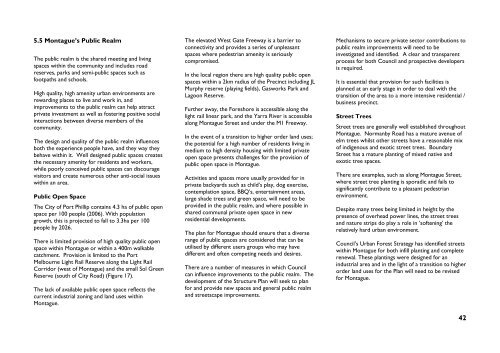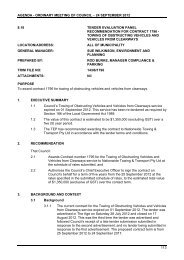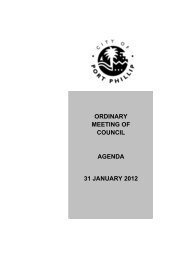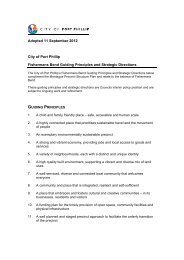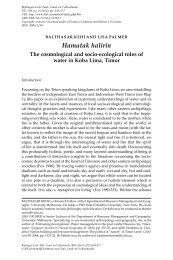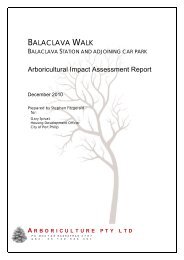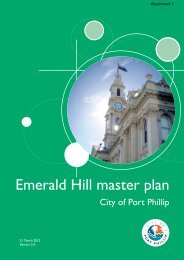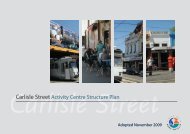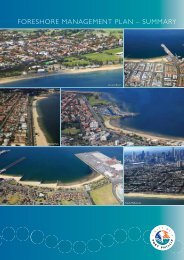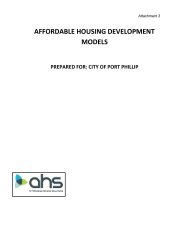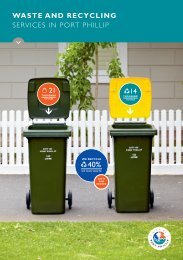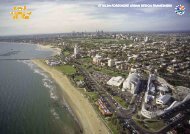Montague Background_Paper.pdf - City of Port Phillip
Montague Background_Paper.pdf - City of Port Phillip
Montague Background_Paper.pdf - City of Port Phillip
You also want an ePaper? Increase the reach of your titles
YUMPU automatically turns print PDFs into web optimized ePapers that Google loves.
5.5 <strong>Montague</strong>’s Public Realm<br />
The public realm is the shared meeting and living<br />
spaces within the community and includes road<br />
reserves, parks and semi-public spaces such as<br />
footpaths and schools.<br />
High quality, high amenity urban environments are<br />
rewarding places to live and work in, and<br />
improvements to the public realm can help attract<br />
private investment as well as fostering positive social<br />
interactions between diverse members <strong>of</strong> the<br />
community.<br />
The design and quality <strong>of</strong> the public realm influences<br />
both the experience people have, and they way they<br />
behave within it. Well designed public spaces creates<br />
the necessary amenity for residents and workers,<br />
while poorly conceived public spaces can discourage<br />
visitors and create numerous other anti-social issues<br />
within an area.<br />
Public Open Space<br />
The <strong>City</strong> <strong>of</strong> <strong>Port</strong> <strong>Phillip</strong> contains 4.3 ha <strong>of</strong> public open<br />
space per 100 people (2006). With population<br />
growth, this is projected to fall to 3.3ha per 100<br />
people by 2026.<br />
There is limited provision <strong>of</strong> high quality public open<br />
space within <strong>Montague</strong> or within a 400m walkable<br />
catchment. Provision is limited to the <strong>Port</strong><br />
Melbourne Light Rail Reserve along the Light Rail<br />
Corridor (west <strong>of</strong> <strong>Montague</strong>) and the small Sol Green<br />
Reserve (south <strong>of</strong> <strong>City</strong> Road) (Figure 17).<br />
The lack <strong>of</strong> available public open space reflects the<br />
current industrial zoning and land uses within<br />
<strong>Montague</strong>.<br />
The elevated West Gate Freeway is a barrier to<br />
connectivity and provides a series <strong>of</strong> unpleasant<br />
spaces where pedestrian amenity is seriously<br />
compromised.<br />
In the local region there are high quality public open<br />
spaces within a 2km radius <strong>of</strong> the Precinct including JL<br />
Murphy reserve (playing fields), Gasworks Park and<br />
Lagoon Reserve.<br />
Further away, the Foreshore is accessible along the<br />
light rail linear park, and the Yarra River is accessible<br />
along <strong>Montague</strong> Street and under the M1 Freeway.<br />
In the event <strong>of</strong> a transition to higher order land uses;<br />
the potential for a high number <strong>of</strong> residents living in<br />
medium to high density housing with limited private<br />
open space presents challenges for the provision <strong>of</strong><br />
public open space in <strong>Montague</strong>.<br />
Activities and spaces more usually provided for in<br />
private backyards such as child’s play, dog exercise,<br />
contemplation space, BBQ’s, entertainment areas,<br />
large shade trees and green space, will need to be<br />
provided in the public realm, and where possible in<br />
shared communal private open space in new<br />
residential developments.<br />
The plan for <strong>Montague</strong> should ensure that a diverse<br />
range <strong>of</strong> public spaces are considered that can be<br />
utilised by different users groups who may have<br />
different and <strong>of</strong>ten competing needs and desires.<br />
There are a number <strong>of</strong> measures in which Council<br />
can influence improvements to the public realm. The<br />
development <strong>of</strong> the Structure Plan will seek to plan<br />
for and provide new spaces and general public realm<br />
and streetscape improvements.<br />
Mechanisms to secure private sector contributions to<br />
public realm improvements will need to be<br />
investigated and identified. A clear and transparent<br />
process for both Council and prospective developers<br />
is required.<br />
It is essential that provision for such facilities is<br />
planned at an early stage in order to deal with the<br />
transition <strong>of</strong> the area to a more intensive residential /<br />
business precinct.<br />
Street Trees<br />
Street trees are generally well established throughout<br />
<strong>Montague</strong>. Normanby Road has a mature avenue <strong>of</strong><br />
elm trees whilst other streets have a reasonable mix<br />
<strong>of</strong> indigenous and exotic street trees. Boundary<br />
Street has a mature planting <strong>of</strong> mixed native and<br />
exotic tree spaces.<br />
There are examples, such as along <strong>Montague</strong> Street,<br />
where street tree planting is sporadic and fails to<br />
significantly contribute to a pleasant pedestrian<br />
environment.<br />
Despite many trees being limited in height by the<br />
presence <strong>of</strong> overhead power lines, the street trees<br />
and nature strips do play a role in ‘s<strong>of</strong>tening’ the<br />
relatively hard urban environment.<br />
Council’s Urban Forest Strategy has identified streets<br />
within <strong>Montague</strong> for both infill planting and complete<br />
renewal. These plantings were designed for an<br />
industrial area and in the light <strong>of</strong> a transition to higher<br />
order land uses for the Plan will need to be revised<br />
for <strong>Montague</strong>.<br />
42


